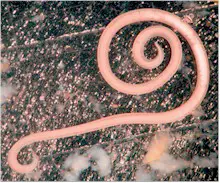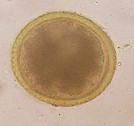Toxascaris leonina is a parasitic nematode common in cats, dogs and other canids (e.g. foxes, coyotes, wolves). It can also infect humans.
canids (e.g. foxes, coyotes, wolves). It can also infect humans.
It is found worldwide. Prevalence in dogs and cats varies in different regions. Studies in the UK showed that up to 20% of urban dogs can be infected with these worms. As a general rule they are more abundant in rural regions where wild carnivores serve as a reservoir. A study in Switzerland showed that about 60% of the foxes in rural areas were infected with Toxascaris leonina, compared with only about 8% of the foxes in urban areas.
Toxascaris leonina is not a bloodsucking worm.
The disease caused by Toxascaris leonina is called toxascariasis. Toxocara cati, a related species infects cats; and Toxocara canis mainly dogs. All belong to a group of roundworms called ascarids (maw worms), together with other parasitic worms of veterinary importance, e.g. Ascaris suum.
Toxascaris leonina does not affect cattle, sheep, pigs, poultry and other livestock.
Are dogs or cats infected with Toxascaris leonina contagious for humans?
- YES. But very rarely. Toxascaris leonina can cause visceral larva migrans, but very much less frequently then Toxocara canis or Toxocara cati. Humans, especially children can be infected after ingesting eggs of Toxascaris leonina shed with the feces. This can happen through direct or indirect contact with the droppings of infected cats and dogs (and also wild carnivores), but also indirectly through eggs in their hair coat. For additional information read the chapter on the life cycle below.
You can find additional information in this site on the general biology of parasitic worms and/or roundworms.
Final location of Toxascaris leonina
Predilection site of adult Toxascaris leonina in the final hosts is the small intestine.
Anatomy of Toxascaris leonina
Adults of Toxascaris leonina have the typical slender shape of worms, with thinner head and tail. They are about 7 to 10 cm long and 2-3 mm wide, whereby females are larger than males. They have a whitish-pinkish color.
The anterior end has two wing-like projections (alae). The head has three prominent lips. The worm's body is covered with a cuticle, which is flexible but rather tough. The worms have no external signs of segmentation. They have a tubular digestive system with two openings. They also have a nervous system but no excretory organs and no circulatory system, i.e. neither a heart nor blood vessels.
The eggs are almost spherical, brownish, measure about 60x80 micrometers, have a thick wall with a smooth surface, and contain a single cell.
Life cycle and biology ofToxascaris leonina

Toxascaris leonina has a direct life cycle, with cats, dogs and other carnivores as final hosts. In contrast with several other ascarids (e.g. Toxocara cati and Toxocara canis) they do not migrate from the gut to the lungs and back to the gut through the mouth.
The eggs are shed with the dog's feces. Once outside the host L2 infective larvae develop inside the eggs in 2 to 4 weeks, depending on weather conditions. These eggs can remain infective for months by cool and humid weather, but die quickly by dry and hot conditions. Cats, dogs and other wild carnivores become infected after ingesting eggs that contaminate drinking water or food. Once in the gut of the final host the L2 larvae hatch out of the eggs, penetrate the gut's wall where they molt twice. After the last molt they return to the gut's lumen, molt to adults and complete development to sexual maturity. The prepatent period (time between infection and shedding of fist eggs) is 7 to 11 weeks.
Transport hosts (often small rodents such as rats, mice, etc.) can also ingest Toxascaris leonina eggs. In these transport hosts L2 larvae that hatch out of the eggs after digestion migrate to various organs where they encyst without completing development to adult worms. When a suitable final host ingests such infected rodents, the cysts release the L2 larvae after digestion. These larvae go directly to the gut and complete development to adults and start producing eggs without migrating to the lungs and back.
Humans can also be infected if they ingest eggs of Toxascaris leonina. The L2 larvae hatch out of the eggs in the human's gut and migrate through the gut's wall to other organs causing the condition called visceral larva migrans. However human visceral larva migrans is mostly due to Toxocara cati or Toxocara canis, and only occasionally to Toxascaris leonina.
Harm caused byToxascaris leonina infections, symptoms and diagnosis
Toxascaris leonina infections are mostly asymptomatic, i.e. infected dogs or cats do not become sick and show no clinical signs. Nevertheless, adult worms in the gut compete for nutrients with the final host and larvae can damage the gut's wall. Heavy infections can cause intestinal inflammation (enteritis) sometimes diarrhea, mucous feces, vomiting, weight loss, dull hair coat and inflated bellies. Puppies and Kittens are more affected than adult animals. Fatalities due to Toxascaris leonina are very seldom.
Diagnosis in dogs is done by fecal examination for detection of eggs. In heavy infections full worms or larvae may be found in the vomit or even in the feces of puppies.
Prevention and control of Toxascaris leonina infections
It is advisable to prevent pets from eating or licking soil or other substrates potentially contaminated with eggs, but this is often very difficult to achieve. In kennels, catteries and boarding houses it is essential to follow strict sanitation and disinfection of cages, boxes, and any places used by the animals. The excrements must be eliminated daily. Non-porous floors make disinfection easier and more effective.
Based on the local epidemiological situation and the pet's specific environment (rural, urban, contact with other dogs, season, climate, etc.) it can be advisable to periodically treat adult pets of both sexes with appropriate wormers as recommended by your veterinary doctor. If available and affordable it can make sense to regularly perform a fecal examination of the dog's droppings. This is particularly important for breeding animals, whose droppings should be periodically examined: if required they have to be regularly dewormed during pregnancy.
After acquiring a new pet, young or adult, it is highly advisable to perform a fecal examination and preventatively deworm it if required. If possible, whatever clinical information should be obtained from the previous owner.
All these measures are especially important in families with young children in close contact with dogs or puppies. In addition children must be instructed to frequently clean their hands with soap before eating, and not to walk barefoot outdoors on places that could be infected with larvae of these worms (gardens, yards, etc). These measures are obviously very advisable for adults as well. On the other side it is also important to train the pets not to defecate in places where the children use to play.
There are numerous anthelmintic products (also called wormers or dewormers) effective against Toxascaris leonina and other roundworms. They contain active ingredients of various chemical classes such as benzimidazoles (e.g. fenbendazole, febantel, flubendazole, mebendazole), tetrahydropyrimidines (e.g. pyrantel), macrocyclic lactones (e.g. milbemycin oxime, moxidectin, selamectin), emodepside, levamisole, piperazine derivatives, etc. They are often used in mixtures, sometimes with specific taenicides (mostly praziquantel) to control tapeworms as well.
Most of these pet wormers are available in formulations for oral delivery either as solids (tablets, pills, etc.) or as liquids (drenches, suspensions, etc.). In some countries there are also a few spot-ons (= squeeze-ons = pipettes) and a few injectables that are effective against Toxascaris leonina
Most wormers kill the worms shortly after treatment and are metabolized and/or excreted within a few hours or days. This means that they have a short residual effect, or no residual effect at all. As a consequence treated animals are cured from worms but do not remain protected against new infections. To ensure that they remain worm-free the pets have to be dewormed periodically, depending on age and the local epidemiological, ecological and climatic conditions.
Excepting a few spot-ons, other antiparasitics for external use (shampoos, soaps, sprays, powders, insecticide-impregnated collars, etc.) are not effective against Toxascaris leonina or other roundworms.
There are so far no true vaccines against Toxascaris leonina. To learn more about vaccines against parasites of livestock and pets click here.
Biological control of Toxascaris leonina (i.e. using its natural enemies) is so far not feasible.
You may be interested in an article in this site on medicinal plants against external and internal parasites.
Resistance of Toxascaris leonina to anthelmintics
So far there are no reports on resistance of Toxascaris leonina to anthelmintics.
This means that if an anthelmintic fails to achieve the expected efficacy, chance is very high that it was not due to resistance but to incorrect use, or the product was unsuited for the control of these parasites. Incorrect use is the most frequent cause of failure of antiparasitic drugs.
|
Ask your veterinary doctor! If available, follow more specific national or regional recommendations for Toxascaris leonina control. |